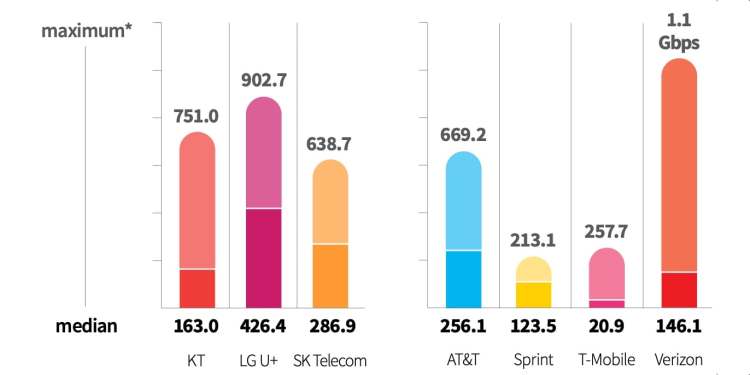Measuring the performance of early 5G networks in the United States isn’t simple — high-speed towers can be tricky to find even in carriers’ first “5G cities” — but once the data’s been gathered, it’s pretty easy to understand. After canvassing three such cities, mobile industry testing firm RootMetrics reports today that initial U.S. 5G network performance is generally much faster than 4G, though it’s uneven between locations and largely lags behind speeds enjoyed by early 5G users in South Korea.
The new RootMetrics study provides additional quantification to earlier anecdotal reports from U.S. cities, focusing on the top four U.S. carriers’ 5G deployments in Atlanta, Chicago, and Dallas. Notably, only Sprint offered “meaningful” 5G presence in all three cities, while AT&T 5G was only in Dallas, Verizon 5G was solely in Chicago, and T-Mobile’s 5G was best in Atlanta, but existed in Dallas as well. While RootMetrics was able to spend a quarter to half of its testing time using 5G on Sprint’s network, its 5G time ranged from only 1.3% to 7.1% on the other networks, hinting at the vast amount of 5G hardware yet to be installed across U.S. cities.
For AT&T, which is currently only offering 5G access to select business customers, the median 5G download speed was over 256Mbps — 13 times faster than its median non-5G download speed. AT&T’s service peaked at 669.2Mbps in RootMetrics’ tests, well below the 2Mbps peak the carrier has seen in internal testing, but still a solid number.
Verizon’s 5G is available to the general public, and its performance statistics were markedly different from AT&T’s: a median 5G download speed of only 146.1Mbps, or just over 4 times faster than its median non-5G download speed in Chicago, but a 5G peak there of 1.066Gbps — faster than any rival, U.S. or otherwise, assuming you can find 5G connectivity. “Despite spending limited time on 5G (7.1%),” RootMetrics says, “the carrier’s 5G speeds were outstanding and indicate a strong foundation for the carrier to build upon moving forward.”
June 5th: The AI Audit in NYC
Join us next week in NYC to engage with top executive leaders, delving into strategies for auditing AI models to ensure fairness, optimal performance, and ethical compliance across diverse organizations. Secure your attendance for this exclusive invite-only event.
T-Mobile’s 5G was available in both Atlanta and Dallas, but its initial performance was oddly worse than 4G in both places — an issue RootMetrics downplayed. The Uncarrier reached a maximum 5G speed of 257.7Mbps in Atlanta, but its median 5G speeds of 20.9Mbps and 13.6Mbps were below its 4G medians of 48.9Mbps and 19.1Mbps. Unlike the other carriers, RootMetrics suggested that T-Mobile’s 4G was strong enough in both median and peak performance to satisfy customers ahead of its 5G transition, though it obviously won’t reach Verizon’s or AT&T’s best levels.
By contrast, Sprint delivered a median 5G download speed of 123.5Mbps in Chicago, over 4.7 times faster than its non-5G service there, but peaked at a middling 205.3Mbps — numbers that dovetailed with our most recent Sprint 5G testing in Los Angeles. From RootMetrics’ results, one might gather that Sprint customers will never reach rivals’ highs, but will spend more time enjoying the mids. Sprint’s peak speeds in Atlanta (213.1Mbps) and Dallas (200.4Mbps) were in the same ballpark, but its median 5G speeds were lower in both cities than Chicago, in some cases underperforming connections to Sprint’s 4G network. Even so, RootMetrics praised the fourth-place carrier for “becoming the first carrier to build a relatively expansive 5G footprint in multiple cities.”
While the U.S. carriers are making progress, they’re generally all lagging behind South Korea’s carriers, which are delivering more consistent gains in both median and peak performance. In Korea, 5G medians range from 163 to 426.4Mbps depending on the carrier, with peaks spanning 638.7 to 902.7Mbps. RootMetrics also notes that 5G is “much higher” in availability in South Korea than in the U.S., which is to say that Korean users have a better chance of actually connecting to 5G towers and of seeing really fast 5G when they’re connected. That’s in part because South Korean carriers are using sub-6GHz radio spectrum for 5G, while most U.S. carriers — except Sprint — launched 5G using millimeter wave hardware.
U.S. 5G buildouts are continuing, and are expected to catch up with the South Korean results in 2020, when more U.S. carriers adopt Sprint-style support for sub-6GHz 5G radio towers. All of the carriers save Sprint have committed to covering large parts of the United States with 5G next year; Sprint is currently awaiting final approval to merge its network infrastructure with T-Mobile’s, creating a multi-tiered 5G giant.

